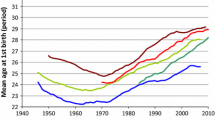Abstract
We present a deterministic model for an age-structured population dynamics taking into account females' pregnancy, maternal care of offsprings, and environmental pressure with or without spatial migration. The model is based on the age-density notion for a group formed by a mother and her offsprings under maternal care. A harmonic-mean-type mating function of sexes without formation of permanent pairs is used. It is assumed that each sex has the pre-reproductive, reproductive, and post-reproductive age intervals. All adult individuals are divided into males, single females, fertilized females, and females taking child care. Individuals of post-reproductive age belong to the group of singles. All individuals of pre-reproductive age are divided into the young and juvenile groups. Only young offsprings are assumed to be under maternal care. Juvenile individuals can live without maternal care. The model consists of integro-PDEs subject to the conditions of integral type. The existence and uniqueness theorem is proved in the case of unlimited population. Separable solutions and their long-time behavior are studied for the limited nondispersing population. In the case of random migration two types of separable solutions and their long-time behavior for the homogeneous Dirichlet and Neumann boundary conditions are studied. In the case of directed migration in one-dimensional domain with special initial and Dirichlet boundary conditions, the unlimited invasive population dynamics is studied. In particular, an explicit formula for the migration front is given.
Similar content being viewed by others
REFERENCES
S. Busenberg and M. Iannelli, Separable models in age-dependent population models, J. Math. Biol.,22, 145-173 (1985).
R. Dinda, Wild Life (Fact File, in Lithuanian), IMP Baltic, Vilnius (2003).
M. E. Gurtin and R. MacCamy, Nonlinear age-dependent population dynamics, Arch. Rat. Mech. Anal.,54, 281-300 (1974).
K. P. Hadeler, Pair formation with maturation period, J. Math. Biol.,32, 1-15 (1993).
F. C. Hoppensteat, Mathematical theories of populations, genetics, and epidemics, in: CBMS Appl. Math. SIAM,20, Philadelphia (1975).
M. Langlais and F. Milner, Separable solutions of an age-dependent population problem with age dominance and their stability, Math. Biosci.,119, 115-124 (1994).
M. Langlais, Large time behavior in a nonlinear age-dependent population dynamics, J. Math. Biol.,26, 319-346 (1988).
S. Moss de Oliveira, Consequences of parental care on population dynamics, Physica A,273, 140-144 (1999).
C. V. Pao, Nonlinear Parabolic and Elliptic Equations, Plenum Press, New York (1992).
V. Skakauskas, Two population dynamics models with child care, Informatica, 11(2), 195-218 (2000).
V. Skakauskas, A density-dependent population dynamics model with offspring production atfixed ages and child care, in: Mathematical Modelling and Computing in Biology and Medicine 1, 5th ISMTB Conference, V. Capasso (Ed.), MIRIAM (2002), pp. 368-373.
V. Skakauskas, Large time behavior in a population dynamics with offspring production at fixed ages, child care, and spatial dispersal, Lith. Mat. J., 44(2), 180-197 (2004).
V. Skakauskas, Large time behavior in a density-dependent population dynamics problem with age structure and child care, in: Math. Modelling of Population Dynamics, 63, R. Rudnicki (Ed.), Banach center publications, Inst. of Math. Polish Academy of Sci., Warszawa (2004), pp. 243-258.
O. V. Staroverov, Reproduction of the structure of the population and marriages, Ekonomika i matematicheskije metody,13, 77-82 (1977).
G. F. Webb, Theory of Non-Linear Age-Dependent Population Dynamics, New York (1985).
Author information
Authors and Affiliations
Rights and permissions
About this article
Cite this article
Skakauskas, V. An Age-Structured Population Dynamics Model with Females' Pregnancy and Child Care. Lithuanian Mathematical Journal 44, 251–271 (2004). https://doi.org/10.1023/B:LIMA.0000046875.66643.f0
Issue Date:
DOI: https://doi.org/10.1023/B:LIMA.0000046875.66643.f0



